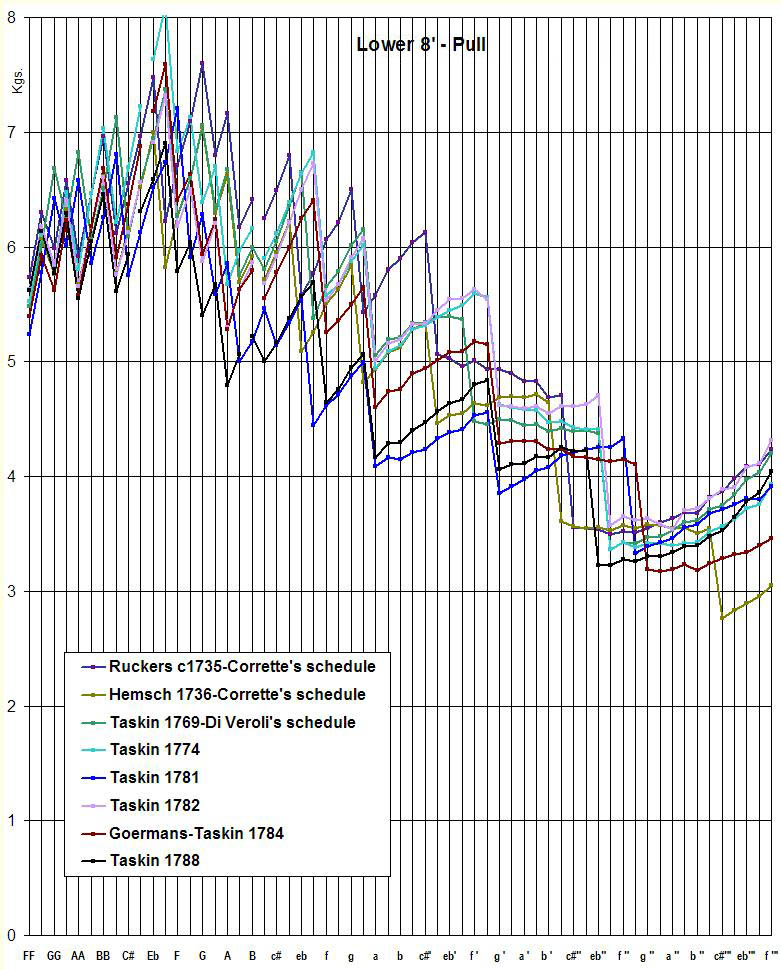TASKIN HARPSICHORD SCALINGS AND STRINGINGS REVISITED
Part 2 - Analysis of Scalings and Stringings
Copyright © 2011 by Claudio Di Veroli, Bray Baroque, Bray, Ireland, March 2011
To Paul Y. Irvin 
Contents
Back to Part 1
6. Analysis of 18th century French scalings and stringings
7. Selecting which Taskin to copy based on pitch
8. Practical application to present-day harpsichord stringing
9. Automating the calculation of a schedule
Part 3 - Appendixes and Bibliography
Typical common features of French 18th c. harpsichord scalings and stringing schedules are that the resulting pulls decrease in subtle ways from bass to treble. The use of the different metal alloys is also quite uniform (O'Brien 1981). On average, the transition points are as follows:
- 8': Red Brass to Yellow Brass at D-Eb, Yellow Brass to Iron at B-c
- 4': Red Brass to Yellow Brass at C#-D, Yellow Brass to Iron at Bb-B
The consistency of the transitions is remarkable: none of the ancient schedules in this study deviates more than one semitone up or down from the above.
It is common in the literature to find statements such as "The Taskin 17XX and 17YY schedules are virtually identical, except for a very few strings …". Actually, however, no two extant schedules of Taskin are identical, and their similarities are as significant as their differences. Closer scrutiny provides important insights: we will show below that—in spite of assertions to the contrary found in modern publications—there is a strong relationship between schedules, scalings and pitches. Let us first perform a simple comparison of our seven ancient schedules—we exclude here the reconstructed one for the Taskin 1769—with no reference to either scalings or pitches. The numbers after the alloy are the original values following the French 18th c. gauge system.
Table 5 - Comparison of French 18th c. harpsichord stringing schedules.
Every pair alloy-size is shown with an individual background colour.
(RB=Red Brass, YB=Yellow Brass, IR=Iron)
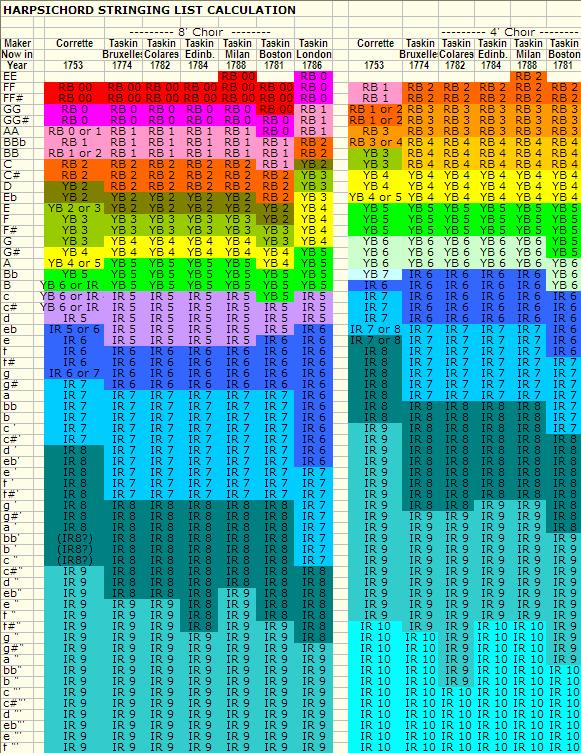
Table 5 shows some trends and also a few inconsistencies:
- As the instruments become shorter, there is a trend for the stringing to be heavier.
- However, the trend towards heavier stringing shows in the treble (c"-f''') a few random variations that need further scrutiny.
- The four "long", "medium" and "medium-short" instruments (1774, 1782, 1784 and 1788) are identically strung in their lowest three octaves (FF-f'), but diverge in the treble.
- The earlier Corrette's stringing—not surprisingly—is lighter than the rest.
- The stringing for the "short" 1781—again not surprisingly—is heavier than the rest.
- As expected, heaviest of all is the "very short" and late 1786, but only in the upper three octaves: in the lowest two octaves, unexpectedly, it is lighter than the rest: this is surely to avoid inharmonicity as expained in the preceding section.
The only correct way to find out the rationale behind ancient scalings, schedules and pitches is to compare their simultaneous effect: the pulls. For this purpose, a complex spreadsheet was setup, which calculates and collates the pulls and stresses of every single string for all the nine instruments listed above in Table 4. As before, it was initially assumed that Taskin had built his Boston 1781 harpsichord for the A=409 Hz pitch of his extant tuning fork of 1794. For the other instruments, we tried other historically likely pitches in order to reach similar pull curves. (Please note that, quite obviously, changing the assumed pitch simply shifts the pull curve proportionally up or down, it does not change the curve’s shape). Eventually it was not difficult to achieve very satisfactory and consistent results, which will be shown further below.
Let us first comment on the final tuning pitches implied—by the pull curves—for the nine instruments in Table 4:
- Ruckers c.1735: A=387. This is a historically consistent value. Mind also that we have applied Corrette's 1753 stringing, as the instrument's original stringing is unknown. We have selected among Corrette's alternatives those yielding a pull curve as smooth as possible.
- Hemsch 1736: A=407. This is also based on Corrette' stringing list. Pitches as high as this one were indeed in use at the time in France. Alternatively, the original unknown schedule may have been heavier than Corrette's general recipe.
- Taskin 1769: A=400. The curves agree perfectly with the others at this pitch, which is considered nowadays to be a likely original pitch for this instrument. [As said before, the reconstructed schedule explained in Appendix 2 was used for the calculations.]
- Taskin 1774: A=400. The only particular feature here is a slightly longer scaling in the bass of the 8', yielding high pulls in the lowest Yellow Brass, especially in the note E.
- Taskin 1781: A=415. Initially we had assumed this instrument to have been built for A=409, the tuning fork Taskin was using at the time for Paris's Opera. Unfortunately, this very instrument is the only one in the set showing a significant departure from the usual shape of the pull-curve, which in the 8' choir is very low in the already-commented Yellow-Brass-to-Iron transition, and also in the range from c to c'. In the 4' choir instead, significantly low pulls are found in the extreme bass, strung in red brass. (Note however that the 4' brass is where the greatest diversity among instruments is observed, as shown in Fig. 4 below). All these peculiarities are consistent with this instrument having been built for a pitch a few Hz higher than the Opera's A=409: assuming A=415 resolves all the inconsistencies, allowing for a very satisfactory match with the other instruments in our set.
- Taskin 1782: A=403. Taskin replicated here almost exactly the 1769 instrument but, very interestingly, applied to it the same schedule as the 1774, except for a few strings in the treble of the 4'.
- Goermans-Taskin 1784: A=387. This instrument was signed by Goermans in 1764: it has a large scaling, and the low pitch is apparent also because Taskin fitted a typical schedule, showing that he had no intention to raise the original pitch (an operation that would inevitably increase the breaking risk for many strings).
- Taskin 1786: about A=412. No matter the pitch, however, the pull curves only agree with the others in the midsize and treble range (g-f'''), but not in the tenor and bass (EE-f#) where the pull drops considerably (to avoid inharmonicity) due to the very small scaling and light stringing. Given the unique peculiarities of this very small instrument, and the fact that it has no 4' choir, it has been excluded from the pull curves in the charts shown further below.
- Taskin 1788: A=420. One would expect the same pitch as for the 1781 instrument, because the scalings are most similar, and since the 1788 is longer in the bass, it should show a slightly higher pull. However, the 1788 stringing schedule is significantly "lighter": at the same pitch, this would imply a significantly lower pull throughout. The inconsistency is resolved by assuming a higher pitch: this is also perfectly consistent with the later date of the instrument.
In most of the above instruments, if one attempts a pitch just a few Hz higher or lower, significant parts of the pull curve move away from the others. With the choices of pitches shown above, the result is an excellent overall agreement in the pull curves, as shown further below.
HISTORICAL PITCHES. Independent sources for average pitches in 18th c. France should also be checked for consistency with the pitches chosen above. From Ellis and others we have the following tuning forks and other established pitches:
- Lille c.1700 A=384.3
- Paris Opera 1704 A=404.0
- Sauveur 1713 A=406.6
- Lille 1754 A=422.6
- Paris c.1756 A=400.0 (from a flute)
- Taskin 1783 A=409.0 (as tuner for the Opera)
- Versailles 1789 A=395.8 (Palace organ, explaining the low pitch)
The general pitch underwent ups and downs, from the 17th century's values below A=400 Hz, eventually reaching about 435 Hz in the 19th century.
The author is satisfied that the historical pitches are quite consistent with the pitches deduced above for the harpsichords under study.
Note that there is no reason why the pitches we reached above for the Taskin's seven instruments studied here should resemble those in Table 3, which had been derived by size/scalings only. When one adds the stringings—as done in the study and commented above—the final "Grouping by Pitch" becomes slightly different, as shown in the following table.
Table 6 - Taskin's harpsichords - Scalings and Grouping by Pitch
|
Year |
Location |
Case Length |
Scaling
of long/back/lower 8' |
Grouping by Scaling & Length |
Pitch A =Hz |
Grouping by Pitch |
||||
|
F |
C |
c |
c' |
c" |
||||||
|
1784 |
|
2365 |
1835 |
1727 |
1207 |
713 |
366 |
long |
387 |
low |
|
1769 |
|
2319 |
1764 |
1617 |
1178 |
711 |
357 |
medium |
400 |
medium |
|
1774 |
|
|
1764 |
1683 |
1183 |
705 |
358 |
medium |
400 |
medium |
|
1782 |
Colares |
2317 |
1770 |
1610 |
1153 |
704 |
360 |
medium |
403 |
medium |
|
1786 |
|
1815 |
1452 |
1390 |
1051 |
638 |
330 |
very short |
412 |
high |
|
1781 |
|
2212 |
1709 |
1566 |
1080 |
626 |
344 |
short |
415 |
high |
|
1788 |
|
2308 |
1761 |
1583 |
1078 |
637 |
345 |
med.short |
420 |
very
high |
After Table 3 above we had concluded that, were pitch the only explanation for the different sizes and scalings of harpsichord, the lowest pitch should be an unlikely A=370 (and even lower). By applying instead the historical schedules and assuming similar pulls, the lowest pitch required is now the much more reasonable A=387: this is because, as calculations have shown, Taskin compensated the reduction in instrument size, not just with a higher pitch, but also with larger wire sizes. Summarising, section 5's inconsistency hypothesis has been shown to be untenable.
More importantly, although any study like this one falls short of a complete scientific proof, section 3's compensating hypothesis fits the data remarkably well. In other words, it all seems to show that, when Taskin used different scalings, he employed matching schedules, yielding pull curves remarkably similar among his different instruments. This is shown in Figs. 3 and 4 below, which include all the harpsichords in our study except for the smallish and 8'-only instrument of 1786. For uniformity's sake the curves are shown over the range FF-f'''. The latest instruments by Taskin had a range going down to EE, but we can safely ignore this low note in this study, because Taskin always strung it using the same wire as for FF.
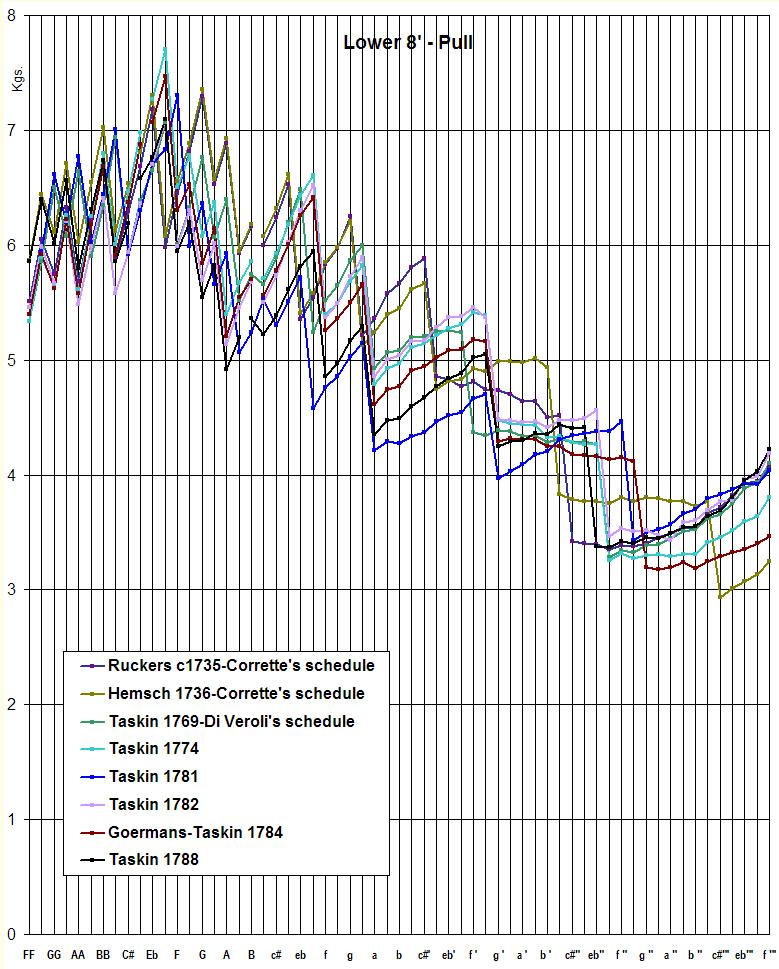
Fig. 3 - Lower/long 8' pulls produced by 18th-century French harpsichord schedules
PULL DROP TOWARDS THE EXTREME BASS. A remarkable feature produced by all the ancient schedules is that the pull in the Red Brass decreases towards the bass. This is caused by the strings being shorter and shorter with respect to their "theoretical" lengths. In the rest of the instrument this is compensated by changing the wire size. In the extreme bass, however, very high sizes would be needed: e.g. for FF a pull of 7 Kg looks reasonable, but this requires a size .028", yielding a very audible inharmonicity. As shown by the schedule, ancient makers found that, in order to strike the best balance, Red Brass size should indeed increase towards the bass, but less so than required to keep a constant (or increasing) pull: thus they went from Gauge 2 (.0182") in D to only Gauge 00 (.0244") in FF.
PULL DROP IN THE 8' CHOIRS OVER THE TRANSITION. Another interesting feature common to most ancient schedules is that the resulting pull curve is slightly low around the transition from Yellow Brass into Iron. This is particularly noticeable in the 8' choirs (Bb to c#). The cause of this drop is that the top Yellow Brass and the bottom Iron are both strung with gauge 5 (.0133"), while for a gradually decreasing pull from bass to treble, a gauge 4 (.0148") would be needed in the transition range. Why would 18th century makers do this? The explanation is found in two facts they were surely aware of, even though not reported in any source:
- TOP YELLOW BRASS. Here the stress is too high and, unless a particularly low pitch is used, the strings will soon break. To mitigate this, some modern makers use non-historical alloys such as phosphor bronze or beryllium copper. This was unavailable to old makers, who instead used yellow brass with the next smaller gauge, which has a higher tensile strength. The side effect is a lower pull, but there is no discernible degradation in sound quality here.
- BOTTOM IRON. Makers have always been aware that iron wire with size .014" or greater produces a poor sound quality in harpsichords and is best avoided: it is highly significant that iron music wire in these large diameters was indeed available in the 18th century, but is not found in any surviving French harpsichord schedule. Due to the smaller wire size used, the pull for the bottom (or two bottom) note(s) in the iron is slightly low, yet it sounds actually better than using a larger wire size.
DIFFERENCES IN THE 8' MIDRANGE. The pull's decrease towards the treble follows slightly different curves in the different instruments. For the Couchet-Blanchet-Taskin 1781, which exhibits relatively low midrange pulls and high treble pulls (Fig. 3), this may simply be due to its many rebuilds in the 18th century, which included moving around bridges and bridge pins (Koster 1994, p. 50), whereby the present scaling differs from the original. Anyway, for all antique instruments, under the pull of the strings, cases undergo deformation even after a few decades, let alone more than two centuries, particularly so in the midrange. They are more stable in the bass and treble, where the spine and cheek help to keep under control the shape of the case and consequently the scalings.
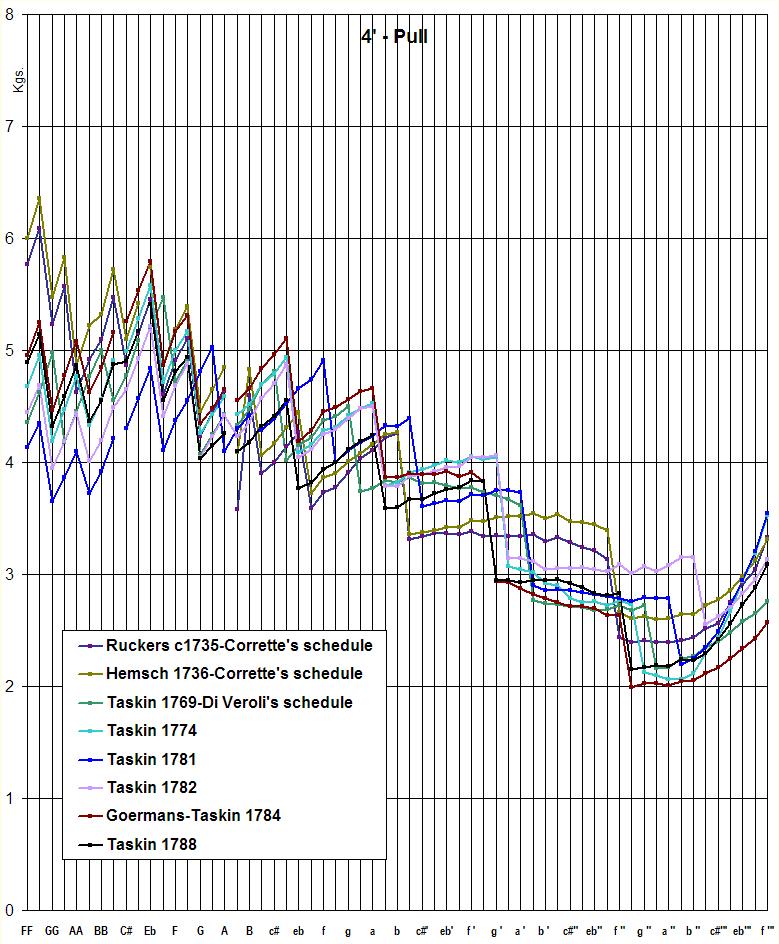
Fig. 4 - 4' pulls produced by 18th-century harpsichord schedules
PULL DIVERSITY IN THE BASS OF THE 4' CHOIR. Not easy to explain (especially the abnormally low values of the 1781 instrument), except that, for some reason, the sound of the bass of the 4' choir is not particularly sensitive to the wire sizes used.
PULL ABNORMALITIES IN THE HIGH TREBLE OF THE 4'. Note in Fig. 4 the peculiar drop in the range g"-b": this is caused by a reduction in wire size greater than needed by the pull progression. Why would 18th century makers do this? Because a smaller size reduces the breaking risk in strings that, due to the register gap, are longer than dictated by the Pythagorean progression: the smaller size also minimises the significant inharmonicity in these short strings. As for the rise in tension after b", this is due again to a long scaling because of the register gap. This could have been avoided by using gauge 11 (.0065"), which was available in Baroque times: however, this gauge was rarely used in harpsichords, and never in the schedules included in this study. Possibly this was because the mass of the strings would be too low to produce the required loudness, or else the wire-drawing process could not guarantee their uniform quality. As commented in Appendix 1, Corrette found that these very thin strings were only suitable for making wigs.
Note: the only instrument that does not show the "4' treble drop" is the Taskin 1782 in Colares: this is due to (a) a different bridge shape whereby strings in the high treble are approx. 4mm longer than in other instruments and (b) a changeover from gauge 9 to 10 located higher up than usual.
From the above 8' and 4' pull curves we can conclude that, for the selected instruments, with their scalings and original schedules, and assuming the hypothetical historically-likely pitches detailed above,
(a) There are no grounds for the inconsistency hypothesis of section 5.
(b) The ancient stringing schedules yield remarkably consistent pull curves, which can be used as models for present-day stringing.
BREAKING RISK RANGE. Common wisdom from ancient times is that instruments sound better when strings are—within safety limits—near to breaking point. In our spreadsheet we have computed breaking risks and observed that, in all the instruments included above:
- Iron strings have mostly risks between 65% and 80%, confirming "common wisdom".
- Yellow brass strings behave differently, because they have very frequent changes of wire size: as we proceed from bass to treble, risk increases from about 50% to about 80%. This still follows "common wisdom".
- Red brass has risks between 33% and 55%. 18th century makers could easily have used red brass in the 8' up to A with no significant risk, yet they stopped at D or Eb at most, surely because they found that yellow brass sounded better from Eb upwards.
ROBUSTNESS OF PITCH ASSUMPTION: All this section 6 and its conclusions rest on an unproved, indeed optimistic assumption: that Taskin was so good that he aurally selected wire sizes for uniform pulls. For this purpose, we have assumed pitches that not only are historically plausible, but also ideally fit the data. What if Taskin was clumsy in this respect? What if the pitches were different from our reconstruction? Could a pessimistic assumption invalidate our conclusions above? Let us check, using pitch assumptions that are fully objective, i.e. independent of both scaling and stringing. One way to do this is to assume that pitch was monotonically increasing with time: instead of our reconstructed pitches for the individual instruments, let us use a straight line showing constant pitch increase per year, starting from A=395 Hz in 1735-36, via 405 in 1769, 409 in 1781-82, ending in 411 in 1788. Our only exception is of course the low-pitch Goermans. See below the resulting tension curves for the long 8' choir.
Fig. 3a - Lower/long 8' pulls produced by 18th-century French harpsichord schedules, assuming monotonically-increasing historical pitches.
Having departed from our previous ad-hoc pitches, the pull curves are now inevitably more dissimilar, but not so much. The issue is limited to the midrange and caused largely by the two worst offenders: the highest pulls are for the Ruckers c.1735 where the use of Corrette's schedule is hypothetical, while the lowest pulls are those of the Couchet-Taskin 1781 where (as detailed above) the bridges are not in their original position. If we disregard the curves of these two instruments in Fig. 3a, we can see that the hypothesis of relatively unified tension curves holds under a pessimistic assumption as well.
7. SELECTING WHICH INSTRUMENT TO COPY BASED ON PITCH
An obvious consequence of the above conclusions is that, if we wish to build a faithful replica of a harpsichord, before we even think about stringing schedules, it seems advisable to select an extant instrument that agrees in pitch—based on its original scaling and stringing schedule—with the pitch to which we will tune our replica. It is worth noting that, when copying an ancient instrument into a transposing instrument, most harpsichord makers do not enlarge the bass: eventually, to avoid losing one or two notes when transposing, the treble parts of bridges and case are enlarged.
Let us illustrate this matter with an example. The maker decides to build a copy of an 18th-century French harpsichord with original range FF-f''', for which the historical stringing list is known and the original pitch is estimated at about A=390Hz. The new instrument is meant to be transposing at A=392/415/440. The maker bases the A=392 pitch on the original, and does not add any further strings in either bass or treble: therefore, when transposing at A=415 the new instrument will have range FF-e''', and when transposing at A=440 the range will be FF-eb'''.
Now let us assume a common scenario with a twist: the new instrument is meant to be used mainly at A=415 and is now required to have for this pitch the full range FF-f''' (thus transposing at A=392 with range FF#-f''' and at A=440 with range FF-e'''). To accomplish this, each string has now to be tuned a good semitone above the pitch of the original. This produces two issues (obvious from what we have seen above in section 6):
1) The pull or load of each string is now higher than the original by 415/390 squared, i.e. by a very significant 13%. The resulting sound will be audibly worse than the original. The solution (widely practised in instruments built until the 1980's) is to devise a new "thinner" stringing list, whereby many strings will have one size less than the original. This will bring all the pulls down to the original value-range, yielding a good (albeit not ideal) solution.
2) The stress or internal tension of each string is ALSO higher by the same amount of 13%. All the strings are now much nearer to their breaking point than in the original instrument. Inevitably, the top strings in the brass range will break, as well as quite a few in the treble iron range. The only solution (widely practised in instruments built until the 1980's) is to use different alloys than the original. For the top of the brass there are different modern alloys that will fit the bill. Also, for evenness and sometimes also to prevent breaking risk, we may need to dispense with red brass altogether in the low bass and string it with yellow brass. As for the treble, at least the upper two octaves will need to be strung in some steel alloy, with significantly higher carbon content than any historically-based iron wire. At this point, we have significantly departed from the original instrument's sound, using non-historical wire alloys throughout most of its range.
The above conundrum has been caused by first selecting an original and then trying to adapt it to modern pitch requirements. What we should do instead, quite simply, is to start from our pitch requirements and then select, as an original, a historical instrument that matches our requirements. If we wish to base our instrument on a Taskin, we are in a particularly good situation because (as we have seen in the previous sections) extant harpsichords by Taskin cover a wide range of pitches.
Let us then list the harpsichord pitches and transpositions in common use today, matching them to the Taskin instruments we have scrutinised (excluding the very small 1786). In transposing instruments, we list the different pitches separated by slashes and, for each recommendation, we clarify which of the two or three pitches is chosen to be a replica of the original, i.e. to follow the original scaling.
- A=392, a"purist" non-transposing instrument for French Baroque music:
• An ideal match is the Goermans-Taskin 1784 in Edinburgh, which had an original pitch at approximately A=387.
• [We may also copy either the Taskin 1769 in Edinburgh or the 1774 in Brussels, with original pitch approx. A=400, but we need a significantly modified schedule to avoid pulls being too low.] - A=392/415, an instrument for general Baroque music use, and
- A=392/415/440, an instrument for general use:
• As above, an ideal match for the A=392 pitch is the Goermans-Taskin 1784 in Edinburgh, with an original pitch at approximately A=387. When used at A=415 it will lack the f''', and at A=440 it will also lack the e'''.
• We may also follow the Taskin 1788 in Milan (originally approx. A=420) for the A=415 pitch: the original EE strings provide the FF when transposed to A=392. At A=440 the f''' will be missing instead.
• [The Taskin 1781 in Boston is also a very good match for the A=415 pitch, but will lack the FF when transposing down to A=392]. - A=405, a"purist" non-transposing instrument for non-French Baroque music, and
- A=405/430, same as above, plus Classical Music: [e.g. for Haydn, who only switched to the fortepiano in the mid-1780's (Di Veroli 2010)]
• The ideal match is the Taskin 1782 at Colares, with an original pitch estimated at A=403. There is no f''' when used at A=430.
• The Taskin 1769 in Edinburgh and the Taskin 1774 in Brussels, at approx. A=400, are also very good matches. - A=415, a non-transposing instrument for general Baroque music use, and
- A=415/440, for use with either Baroque or modern instruments:
• The ideal match is the Taskin 1781 in Boston, originally at approx. A=415. There is no f''' when used at A=440.
• [The 1788 in Milan at approx. A=420 is also a good match in scaling and stringing, but is longer and very late.] - A=430, a "purist" non-transposing instrument for Classical use [e.g. Haydn]:
• The best choice is the Taskin 1781 in Boston, originally at approx. A=415. A slightly modified schedule is needed, or else the pulls are too high and a few strings will be too risky.
• We may alternatively copy the Taskin 1788 in Milan.
8. PRACTICAL APPLICATION TO PRESENT-DAY HARPSICHORD STRINGING
Devising harpsichord schedules is a complex topic: a recent work provides a comprehensive treatment (Donahue 2007). Our final goal here, as stated in section 5 above, is to facilitate harpsichord stringing following historical pulls. The schedule of any instrument, antique or replica, is to be calculated by reference to "weighted average" and "envolvent curves" in the computer chart: they define the "pull space" of ancient schedules, as shown in Figs. 3 and 4 above . We then try to string the instrument following as much as possible the weighted average curve. We may have to depart from the latter, however, for two reasons:
- The wire sizes available today—from some of the best suppliers of traditional harpsichord wire—may not allow to follow very closely the weighted average curve.
- Even if the pull curves cater for our particular instrument's scaling and tuning pitch, this has further implications for the breaking risk: this is often higher than in ancient instruments, because of the higher pitches in use nowadays.
For every long-8' and 4' string, the maker has to calculate both the pull and the breaking risk, using the simple formulae included in section 4 above. We only need a further information, which is provided by the wire supplier:
B = Breaking limit or Tensile strength of the wire (Kg/mm²).
If the breaking limit is provided in other units, it can be converted into Kg/mm² multiplying it by a suitable coefficient: if the original unit is "Mpa" the coefficient is 0.10195, while if the original unit is "PSI" the coefficient is 0.0007031.
Finally, from B we have to calculate the breaking risk,
R = Risk of breaking the string as a percentage of its breaking limit,
using the simple formula R = T / B, where T is the stress calculated as per formula (1) in section 4.
The percentage R is not expected be very accurate, because the value B that wire resellers provide comes from tests run under ideal laboratory-test conditions. In addition, actual wire strength depends not only on the alloy but also on the wire-drawing process (Louchet 2009 Chapter 4), which may vary even between batches by the same supplier. Finally, as is well known, every harpsichord string is further weakened by the torsions in the eye and around the wrestpin. All things considered, the following is a good general safety guideline:
RED OR YELLOW BRASS: The breaking risk R should not exceed 70 % and surely not 80%.
IRON OR STEEL: The breaking risk R should not exceed 80 % and surely not 85%.
VERIFICATION. In the 1980's the author tested a few string coils and found that, due to the above-mentioned "variation" and "weakening", they broke at about a semitone below reported tensile strength: brass strings were the worst offenders. Recent tests show similar results (Donahue 2008 p.143-144). To these conclusions a safety factor needs to be applied, to cater for both variation in quality and variations in pitch. Ancient sources recommended having strings at least a semitone below the point at which they would break in the instrument. We thus have a total of two semitones, equivalent to about 80%. It all tallies with the percentages recommended above.
Note also that, when initially stringing an instrument, it is best to tune it first a tone below and to bring it up to pitch after some days: under these ideal conditions the author has tested that strings will often resist up to the reported tensile strength (i.e. 100%). However, employing a risky schedule is not advisable, because the harpsichord owner needs the instrument to be available at all times for practice and performance: when a string breaks, it should always be possible to replace it and to pull it immediately up to pitch (for example during a recital), without any significant risk of breaking again.
The above considerations imply that breaking risk may force us to depart from the average pull curve for the instrument: this will happen if the instrument is to be tuned at a significantly higher pitch than the original. In such a case, the solution is to lower the pull throughout via thinner strings, which have higher tensile strength. The result is fully satisfactory, i.e. close enough to the ancient stringing, provided we manage to stay—or depart minimally—within the boundaries specified by the historical envolvent curves, which delimit the "pull space" of historical stringings.
The computer-calculated envolvent curves and average pulls for historical Taskin harpsichords are shown in the charts below, Figs. 5 and 6. As an example, they include the pulls of an optimal schedule devised by the author for an imaginary copy of the Milan Taskin 1788, to be built transposing at A=392/415/440. The curves in the charts show the pull at A=415Hz, using Vallotti as a representative of a typical 18th century temperament: this accounts for the non-smoothness of the green curve (anyway the differences between different circular temperament are not significant for stringing calculations). The breaking risk is shown by red dots and only for values above 70%. Needless to say, the instrument maker should measure the scalings in the finished copy before proceeding with the calculations. The same is valid for restringing an existing instrument.
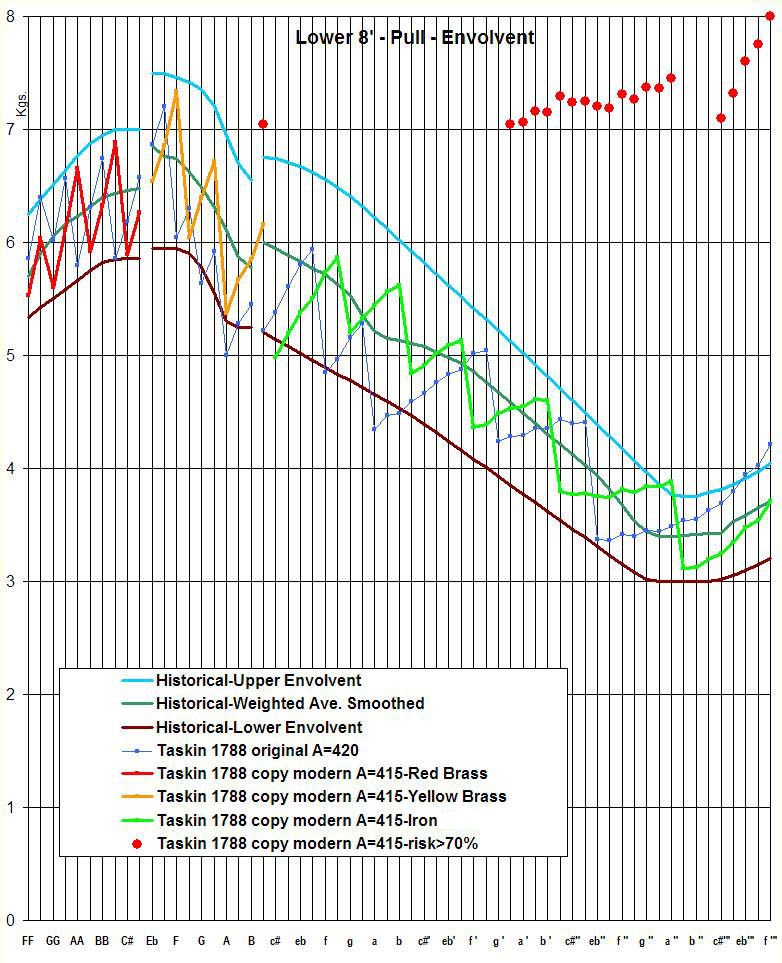
Fig. 5 - Historical pulls for the long/back 8' choir in Taskin's harpsichords: envolvents and weighted average.
The chart also shows the schedule for a modern copy at A=415 Hz based on the Taskin 1788.
Comments on the manual selection of alloys and gauges shown in the above chart for the 8' of a modern copy:
- The chart clearly shows that there are no problems whatsoever in selecting, for the Red Brass and Yellow Brass strings, modern sizes (decreasing first by .002" then by .001") that fit neatly inside the historical envolvents.
- The transition to iron shows an easy-to-circumvent issue: pitched a few Hz below the original, the modern instrument reduces the pull, causing it to fall below the envolvent for c and c#. The issue is negligible for c#, but c would have a tension below 5Kg, sounding slightly "buzzy": rather than stringing it with poor-sounding iron .014", thanks to the lower tension we can string it with brass .014" with excellent sound and a safe 70% risk, as shown by the red dot.
- The extreme treble is strung with 0.0084" in the original. With our lowered pitch, modern .008" would yield too low a tension and mass for a satisfactory timbre and loudness: therefore we have kept size .009" up to a". From b" flat up, with higher tension due to the increased string length, we shift instead to .008" in order to lower both inharmonicity and breaking risk, which reaches the safety limit of 80% in the shortest string only.
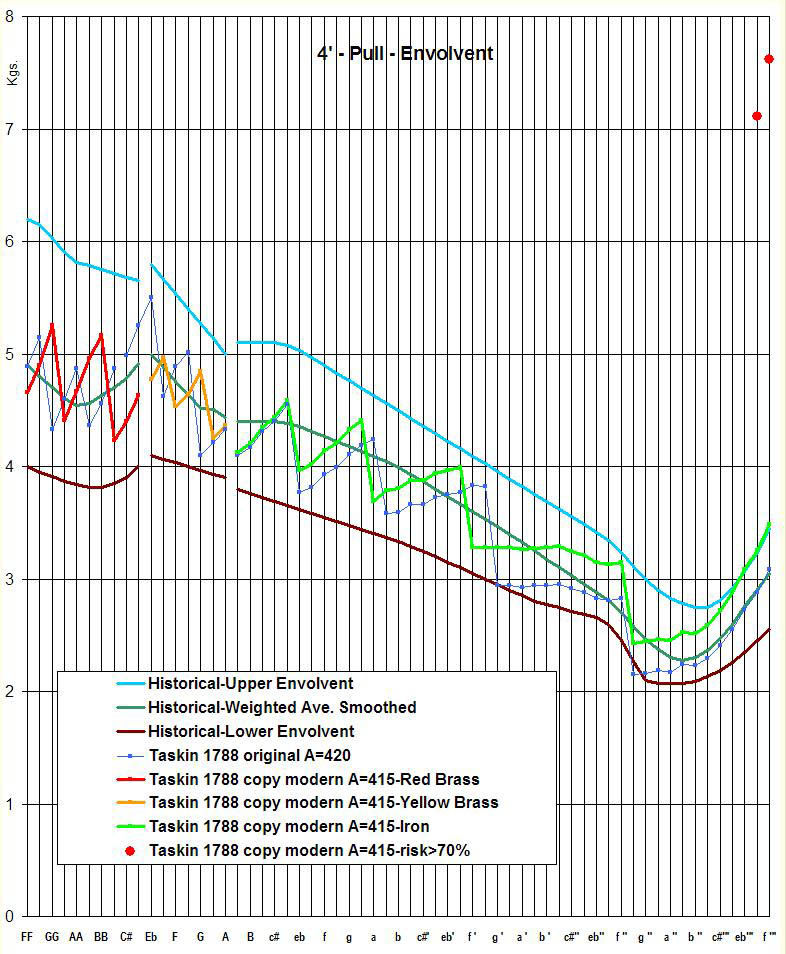
Fig. 6 - Historical pulls for the 4' choir in Taskin's harpsichords: envolvents and weighted average.
The chart also shows the schedule for a modern copy at A=415 Hz based on the Taskin 1788.
There are no particular features to comment for the 4': there are usually no difficulties in selecting alloys and sizes to fit the historical pull envolvents, keeping breaking risk below safety limits.
The above methods have been successfully applied to the restringing of the Taskin-based Hubbard-Di Veroli harpsichord. Two further matters deserve a special treatment.
REPEATING SIZES IN ALLOY TRANSITIONS. At the beginning of section 6 above we listed the four traditional alloy transitions in French 18th-century harpsichords. An interesting question is: when we string two contiguous notes with different alloys, should we try to use the same wire size? Donahue (2007 p. 344) has observed: "there is the evidence that wire sizes were repeated. The problem is that there is also evidence that wire sizes were not repeated. ... the repeating scheme results in a less drastic jump in tension from treble to bass at the transition." (Donahue quotes other studies for support). Not surprisingly, this sensible policy was strictly followed by Taskin, as shown in his six extant schedules in Table 5 above: in the 8' he goes from RB 2 to YB 2 and from YB 5 to IR 5, while in the 4' he goes from RB 4 to YB 4 and from YB 6 to IR 6. However, as Donahue writes, this was not—and should not be nowadays—an absolute rule. Corrette and others did not follow it. In our example schedule for the Taskin 1788 copy, we have followed three of the four Taskin repeating transitions. The exception is the 8' brass-iron transition from YB 4 to IR 5: we could "repeat" stringing the two top brass strings with YB 5 as per Taskin's schedules, but this would yield (because of the pitch A=415) pulls that are too low (5 Kg) for the brass.
UNEQUAL TEMPERAMENTS. (See Di Veroli 2009) The calculation of frequencies—used in the formulae for stresses and pulls—is not as straightforward as it seems. This has usually been calculated from a tuning fork frequency for A, successfully multiplied or divided by the Equally Tempered semitone ratio 1.0594631 in order to get the frequency of each note within the instrument's range. However, if the instrument will be tuned in a decidedly unequal temperament, the significantly-different frequencies are to be calculated instead. You do not need to calculate strictly following the temperament: it is enough to distinguish, say, a circular temperament from meantone, as the latter may have up to 4 notes per octave with different pitches producing significantly differences in the stresses and pulls. With any unequal temperament the pull curves are no longer smooth, affecting the ideal locations of "transitions" between wire alloys and sizes. Also very importantly, they produce peaks of stress as well (Donahue 2007 p. 349). For example, for 1/4 S.c. meantone with wolf at G#-Eb, the spreadsheet curves show that the five "chromatic" semitones C-C#, Eb-E, F-F#, G-G# and Bb-B are particularly bad places for a transition between alloys or sizes: for a smoother pull curve it is best to locate the wire size transitions at any of the other seven "diatonic" semitones. Note however that, if either the instrument is to be tuned with varying temperaments or is a transposing one, the above is no longer valid: calculations show that the best policy is now to calculate "average" tensions, which implies to use Equal Temperament, but with an additional safety factor (deducing 2% from the above values 70%, 80% and 85% is more than enough) to cater for the additional peaks in stress.
9. AUTOMATING THE CALCULATION OF A SCHEDULE
The author back in the 1980's developed a fully automated computer program for stringing list calculation: the program was successfully used by the Argentinian harpsichord maker Leopoldo Perez Robledo. A recent book (Louchet 2009) promotes a commercial service for schedule calculation: this can be both speedy and convenient, though quite obviously, for French 18th-century instruments, Louchet's system cannot possibly take into account the conclusions of the present study, which are significant as they affect the historical pull curves to be followed.
If one is familiar with advanced calculation methods, it is not difficult to set up a spreadsheet that fully automates the determination of both alloy and wire size. For each string, the procedure finds the best fit for the historical weighted average pull. If some strings are too risky, a parameter can be introduced that lowers pulls—all or by groups—until a suitable compromise solution is reached: however, this may imbalance the pull in the brass strings, requiring further corrections.
Nowadays, all things considered, the author prefers instead a manual computer-aided procedure: in a suitably organised spreadsheet, for each string the user manually tries different alloys and sizes, reading in the charts the pulls and checking how they fit—or else—inside the historical envolvents. By trial and error it is not difficult to get eventually a pull curve that follows historical shapes and boundaries, while stresses are kept within safe limits, as shown in Figs. 5 and 6 above.
Please read the final part of this study in Part 3 - Appendixes and Bibliography Back to Part 1
USE OF THIS TEXT, TERMS AND CONDITIONS
Quoting text: Copying text from this webpage and inserting it in other publications or webpages is automatically allowed provided the following conditions are met:
a) As customary, the text copied must be included between quotation marks and left unmodified except for deletions. The latter should not change the meaning in any way and should be identified with ellipses.
b) The source must be quoted as "TASKIN HARPSICHORD SCALINGS AND STRINGINGS REVISITED, Bray Baroque, Bray, Ireland 2011. http://harps.braybaroque.ie/Taskin_stringing.htm".
c) The author should be immediately notified by email: see http:/play.braybaroque.ie for details.
Quotes/copies not adhering to the conditions indicated above will be considered in violation of the author's copyright and legal action may follow.
Disclaimer: The assertions made here about persons and writings are based on evidence from duly acknowledged published material, current at February 2011. The author will not accept responsibility from any offence or damage caused by reading this webpage: its contents is read and used at the user's own risk. For any issues re the above, please feel free to email the author: see http:/play.braybaroque.ie for details.
Page last updated:
22-Mar-2016
